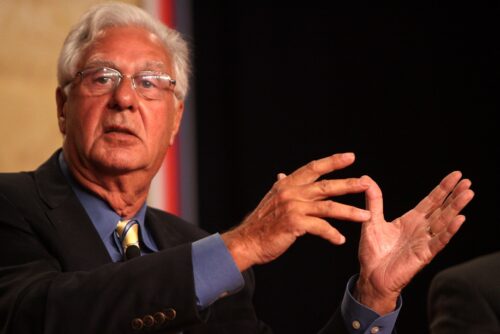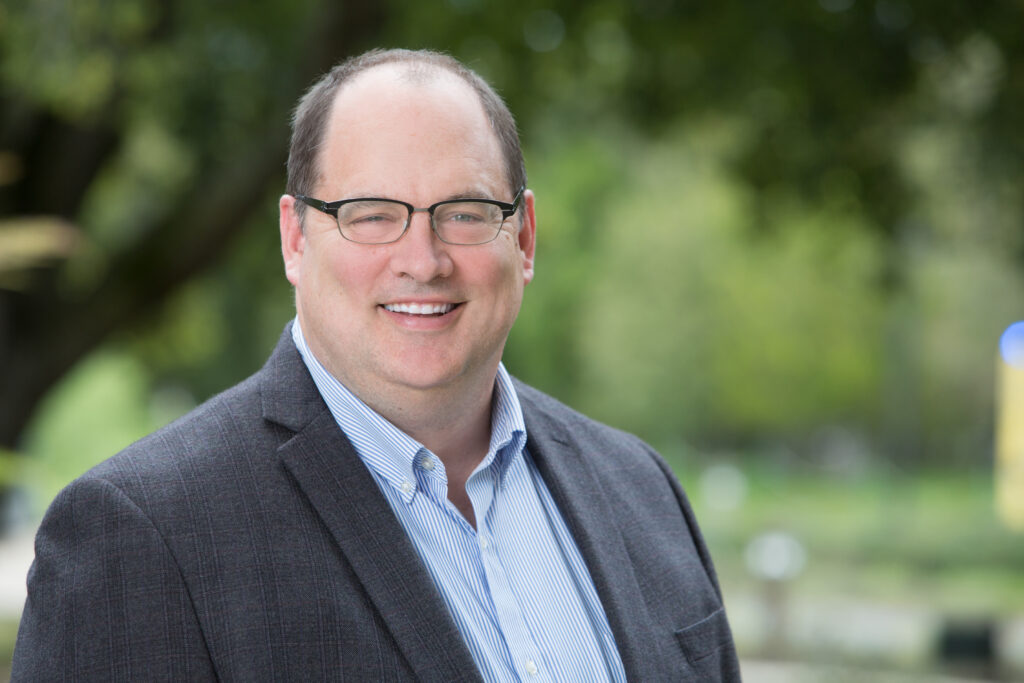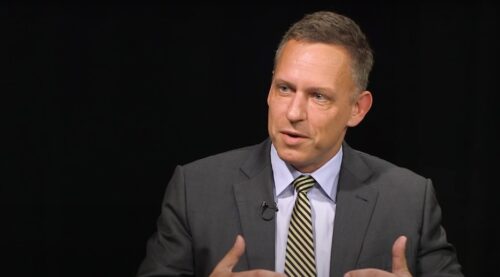The Madison Initiative director talks about his early career, management consulting, and philanthropy.
Daniel Stid directs the Madison Initiative at the $9.8 billion William and Flora Hewlett Foundation in Menlo Park, Calif. The Madison Initiative is an eight-year, $150 million grantmaking effort to, as Hewlett describes it, “support the key values and institutions of democracy—in particular Congress, the first branch of government—in our polarized age.”
Stid came to Hewlett from Bridgespan, the national nonprofit-consulting group, before which he worked for the Boston Consulting Group, which serves for-profit clients. Previously, he was a political-science professor at Wabash College.
Stid was once an American Political Science Association Congressional Fellow, serving on the staff on then-U.S. House Majority Leader Dick Armey, and he is author of The President as Statesman: Woodrow Wilson and the Constitution.
Below is the first of two parts of an edited transcript of a discussion that Stid was kind enough to have with me in September. The second part, in which he talks about Congress, the Madison Initiative’s grantees, philanthropy, and “philanthropic pluralism,” is here.
Hartmann: Where is home? Where’d you grow up?
Stid: I grew up on a family farm in Mason, Mich., which is in Ingham County in the mid-Michigan region.
Hartmann: Where did you go to school?
Stid: I went to local public schools. My father was on the school board. I had a quintessential small-town, farming-community upbringing. You went to the fair in the summer and the football games on Friday nights, that sort of thing.
Hartmann: Where was undergrad?
Stid: I went to Hope College in Holland, Michigan. On a good day, you might be able to see it from Milwaukee. I did a B.A. in history and political science.
Hartmann: Then you got other degrees?
Stid: After Hope, I did a master’s in politics at Oxford in the U.K. and then came back and did a Ph.D. in government at Harvard.
Hartmann: And your first job out of Harvard was …?
Stid: My first job was at Wabash College, a great liberal-arts school in Crawfordsville, Indiana, where I taught for three years in the mid-’90s. I was teaching the American politics curriculum. It was a four-person department, so I taught everything having to do with the U.S. I also taught a course that all students at the college took as sophomores called “Cultures and Traditions.” which was a Great Books course. It was a wonderful course to teach, because there were several masterful senior teachers who would mentor and guide the younger faculty teaching alongside them.
In the middle of my time at Wabash, I had the opportunity to do a Congressional Fellowship, which is a program sponsored by the American Political Science Association. Each year, they bring eight to 10 political scientists to Washington and have them work in a Congressional office. I had the good fortune to catch on with the staff of Dick Armey in the Majority Leader’s office. This was the 104th Congress in 1995 and ’96. It was the first time the Republicans had the majority in the House after 40 years or so in the desert, so it was quite a quite a heady time to be there.
Hartmann: How did you end up with Armey? Do you consider yourself a conservative?
Stid: Obviously, I’m nonpartisan in my professional capacity at the foundation, but my background is that of a Midwestern Main Street Republican. I had a connection with an academic who knew some people in Armey’s office, which had been the internal organizing body for the Republican minority. It had orchestrated the coalition-building that led to the Contract with America and then the legislative agenda that was emerging out of it.

Dick Armey (Wikimedia Commons)
I was ecstatic to find a place in Armey’s office and very grateful for it. There was a very talented group of people on the staff who went on to do a wide variety of big things afterwards. It was a high-caliber group to be a part of.
Helping and humility, learning and lean staffing
Hartmann: What can management consulting and management consultants bring to philanthropy?
Stid: There’s a lot of pitfalls, which we can get into. But there are three things that excellent management consulting can bring to bear that that support excellent philanthropy.
The first thing is what I would call a philosophy of helpfulness and subordination. I remember my first day on the job at the Boston Consulting Group, which was the firm I worked with after leaving Wabash. Our CEO, Carl Stern, was giving a talk to all new recruits. He said that consulting is a helping profession, that your job is to support your clients, and that your client’s interests come first.
That is the ethos that also characterizes the best philanthropy. It’s not a precise analogue, but the idea is that funders succeed not because of the great work that they’re doing, but because of the great work of the organizations they support are doing. That ethos and presuming that the initiative lies with the organization being supported is something that was deeply imprinted on me in my apprenticeship as a consultant at the firms I worked with. It’s something that I brought with me to philanthropy.
A second thing that the best management consulting does is place a huge emphasis on learning, on sifting through multiple and often-confusing pieces of evidence and trying to understand what’s really going on—to look at things squarely in the face and not shy away from hard problems, and to develop strategies and plans accordingly. That grounding in a very intellectually humble and empirical stance vis-à-vis the world is important.
The third idea that comes from consulting is a recognition that it’s better to have a serviceable strategy and a great organization carrying it out than a perfect strategy and an okay organization, because the ability of organizations to shoulder the load that they’re taking on is so critical in executing the strategies that consultants develop for their clients. In the same way, philanthropy needs to be attuned to the capacity of nonprofit organizations to carry out their missions, and to support grantees through both general-operating-support grants and capacity-building grants to help them do that.
Those are the ways in which I would say a background in professional management consulting has helped me in my work at a foundation. There are a lot of pitfalls and we can talk about those, but there are some real benefits of my professional lineage, so to speak.
Hartmann: This humility you reference—of deferring to either the client or the grantee, essentially—is that a minority position in philanthropy, among philanthropoids?
Stid: What I am talking about here is intellectual humility, in terms of not presuming that you know the answer. It’s important to ask the right questions and gather the facts and reconsider your priors as you’re figuring out what to do. To me, the best management consulting and the best philanthropy are characterized by that intellectual humility and the quest to learn and to try and get closer to the truth.
The philosophical disposition vis-à-vis the grantees of an ethic of client service and servant leadership is critical. We know of a lot of instances where that may not be as evident in philanthropy, but there are a lot of institutions that endeavor to bring that to bear.
Certainly, that’s an ethos that has been cultivated at the Hewlett Foundation. We have, for example, a guiding principle that we are leanly staffed, and the reason that we’re leanly staffed is not simply or primarily about efficiency or not spending a lot of money on administrative expenses—rather, it reinforces the norm that our job is to find outstanding organizations and leaders and support them but let them do the work.

Hewlett Foundation, Menlo Park, Calif. (Wikimedia Commons)
If you’re leanly staffed, even if you wanted to do the work that the grantees need to do, we wouldn’t be in a position to do it. There are institutional arrangements that can make that more or less likely among foundation staff. I’m happy to work at a place that has them in place.
Hartmann: When I was at the Bradley Foundation, I think we would have said we were doing the same thing. Bradley would have linked it to its conservatism. Is that fair to do?
Stid: I don’t think it is dependent on a particular political disposition. At least during the period I’ve been involved in this work,a number of funders on the right have started to adopt some of the same practices that for many years, we could criticize funders on the left for—making shorter-term, specified-project grants versus multi-year, general-support grants.
I don’t think it’s conservatism per se that leads to the approach I am advocating for. It’s more of a sense of what’s the appropriate institutional role of philanthropy vis-à-vis the organizations that it’s supporting, and what’s the best pathway for achieving results through philanthropy.
Consulting, consumption, and constraints
Hartmann: You mentioned some pitfalls to management consulting in philanthropy. What might those be?
Stid: There is certainly one worth mentioning, in the spirit of being intellectually honest. Foundations can come to over-rely on outside consultants. Consulting is a professional service. Typically, the consumption of a service is governed by limited resources. For your typical firm or nonprofit organization, when they are retaining a management consultant to help them with a strategy or organizational problem, they have some resources allocated for it, but they’re not limitless. There are real constraints. Everyone needs to be thinking about what would provide value for money.
With foundations that are consuming consulting, there are fewer financial constraints. You can get into what I would call “analysis paralysis,” where the foundation continues to commission different assessments or data-gathering exercises or analyses that don’t provide incremental value and actually reach diminishing returns.
In fact, this was one of the great things about working at Bridgespan, which is more mission-driven as a nonprofit than a profit-drivenfirm. We would go to our foundation clients and say we think this project should be wrapped up because you’re not going to get more bang for the buck if you keep investing in it. Or alternatively, when it came to projects that foundations wanted to start doing, but weren’t set up for success, we could say we don’t think this project is going to succeed and decline to do it.
Foundations need some checks and restraints on consulting. In addition to being leanly staffed at Hewlett, we also have a lean administrative budget. There are internal constraints. We do periodically use consultants, but there are budget constraints that push us to do that judiciously. We have to justify to ourselves and our colleagues why they’re warranted. That’s a potential pitfall that foundations can fall into with consulting.
Hartmann: Any other distinctions between the kind of for-profit consulting you did at the Boston Consulting Group and the nonprofit consulting you did at Bridgespan?
Stid: First, to be clear: I appreciated and greatly benefited both materially and professionally from my time at BCG. But that is a professional firm that is there to support profit-seeking entities and make a profit itself. That’s BCG’s incentive structure. At Bridgespan, especially in the early days, people were leaving positions at for-profit firms to take a lower salary and dedicate themselves to the health and well-being of their nonprofit clients. That was one big difference that had profound cultural implications for our collective sense of purpose.
Another difference was if you’re working in a for-profit setting doing analyses or developing a pricing model or a market analysis for a firm, that is necessarily and appropriately highly confidential and proprietary information. The advantage to the firm commissioning the consulting is to get that insight and operationalize it internally, but not share it externally.
Bridgespan is in the nonprofit world, where there are different imperatives. Let me give you an example. One of my clients, the First Place Fund for Youth in Oakland had developed some innovative ways of supporting emancipating foster youth in California. That’s knowledge and insight that the agency itself and the people funding it, as well as the State of California, had an interest in making widely available to people doing similar work elsewhere. The ethos of actually sharing knowledge gleaned in a particular consulting engagement to advance the broader field is not only possible, but essential and desirable in the nonprofit world. That was one of the things that I found very exciting and rewarding about nonprofit consulting.
Hartmann: If somebody’s a well-to-do individual giver, I assume you would laud the benefits of checking out what Bridgespan could offer.
Stid: Yes, this is a trend, and I totally understand it, within philanthropy. More donors are asking themselves, Do I want to set up a staffed foundation that will exist in perpetuity, and get both the benefits but also the not-insubstantial challenges that come with that?
Or alternatively, Do I want to try and oversee and do this giving while I’m living? Rather than suddenly taking on not just the expense, but also the management and alignment issues of a staffed foundation, maybe it would behoove me just to retain some people to help me sift through the issues in a particular field, identify the major grantees, and then I can just write the checks myself. You’re seeing a pattern over the past five or six years in particular of more and more donors not only giving while living, so to speak, but also using their family offices and relying on external philanthropic advisors to avoid the fixed cost of a staffed foundation
I work at a staffed foundation. There are real benefits and attributes that come with it. But you’re seeing the emergence of a viable alternative model, and that’s one for which periodic outside-consulting support can be helpful.
The conversation continues in Part 2 of 2 here.






